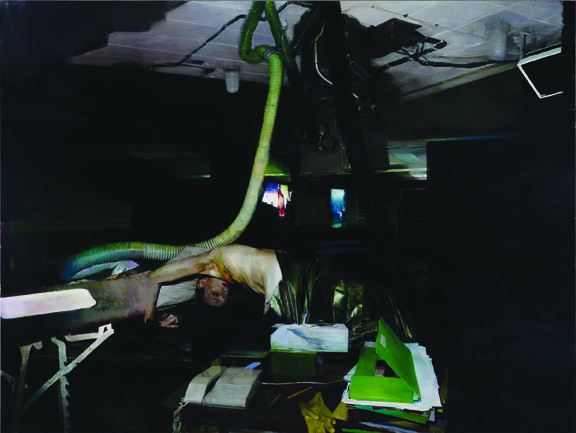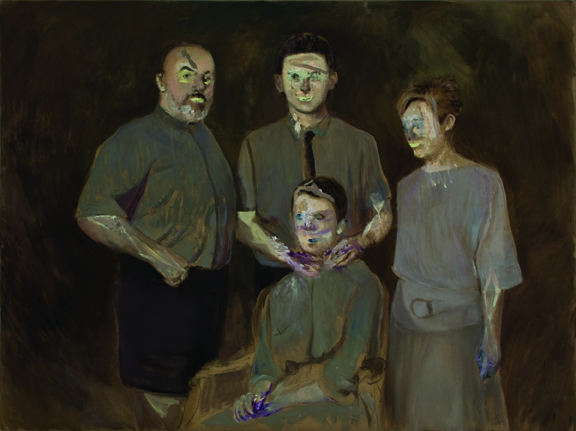Nightfall / Alkony New tendencies in figurative painting
Galerie Rudolfinum, Prague, Czech Republic, March 29 – May 24, 2013
MODEM, Debrecen, Hungary October 7, 2012 – February 10, 2013
Mankind has always been fascinated by darkness. In the beginning as the Bible says, “darkness covered the face of the deep” and since then looking into the abyss is part of human history. We associate the unknown with darkness and surely darkness will accompany our end. Why do we love dark visions such as the end of the world? Why is shivering with fear so appealing to our fantasies? Why do we always go for the worst possible scenario?
The answers to these questions might be very different if the show was in North America. In Europe, generations of people have suffered greatly and struggled just to survive. Memories fill their minds and bodies as much as blood and bones do. The fall of communism didn’t bring the positive changes Europeans expected — and even brought the opposite for Central and Eastern Europe. Materialism replaced morality and little hope was left for the individual. That’s why it is not surprising that all of the pieces in this show are dark and depressing.
The word Nightfall, the title of the show, suggests threatening shadows, foreboding, and anxiety about the end of an era and an uncertain future. The original idea came from Isaac Asimov’s science fiction short story of the same name (1941) about the coming of darkness to the people of a planet ordinarily illuminated at all times on all sides. As the catalogue’s foreword states, quoting William Orville Douglas, “As nightfall does not come at once, neither does oppression. In both instances, there’s a twilight where everything remains seemingly unchanged, and it is in such twilight that we must be aware of change in the air, however slight, lest we become unwitting victims of the darkness.”
Most of the exhibiting artists were born during the Cold War, so being alert to lurking political, ideological or even physical danger is second nature to them. The fall of the Berlin Wall in 1989 and the euphoric feelings of freedom that followed made the 1990’s a big, happy party in Europe. Shadows of social and intellectual disillusionment started to creep in by the end of the decade and the new millennium brought 9/11, wars against terrorism and natural catastrophes like tsunamis and famines. The party was over and the “New Dark Age” came in with depression and economic instability in the European Union.
MODEM organized this very impressive and expensive show – works were coming from all over the globe with sky rocketing amounts for insurance and shipping – in order to put Hungary on the map of the contemporary art world. The show fulfilled all the artistic expectations and became one of the most exciting and complex exhibitions of 2013.
British curator Jane Neal grouped the paintings around five themes: Broken Landscape and Twisted Beauty; Portraiture; Struggle for Identity and the Hidden; Under Cover of Darkness; Painting and Cinema and Home but not Safe. Sometimes it is almost impossible to distinguish between the categories since portrait, identity, and home are often overlapping themes and a cinematic approach can accompany any style.
Swedish artist Karin Mamma Andersson’s paintings are good examples covering more than one theme. In Night Guest an electric storm is brewing with monster-shaped clouds overhanging a farmhouse and a small group of people. Will they be able to outrun the storm? It seems that they not even trying as they are involved in their talk. Maybe they don’t even recognize the approaching danger. Andersson creates tension by making the foreground look ‘normal’, an ordinary farmhouse, people walking toward it, nothing special. The sky seems to be a different world, not connected to the people. The light coming from it is heavy with the foreboding that something terrible is about to happen. The confrontation of the dark blues of the sky and the yellows of the ground is nerve racking. Neither the landscape nor the house is safe.
Andersson’s other paintings in the show focus on home but don’t fare any better. In Coming Home the mother and child face a ruined place where only the gate remains, but rocks and mountains separate them from their home – peaceful and inviting but far out of reach. Hernan Bas, a Miami-born and Detroit-based artists’ work also takes place in the outdoors. His fall 2012 exhibition at Galerie Perrotin, Paris, Thirty-six Unknown Poets (or, decorative objects for the homosexual home) shows the influence of the literature and artistic culture at the end of the 19th century, as well as television and digital imaging. The acid hues and pixelated texture depicts young men in romantic poses so they remind us equally of images from Egon Schiele and British fairies. In The Hallucination of Poets, a pair of those fairies/poets are placed in a landscape that looks beautiful at first sight, until we recognize that all the trees are dead and painted with bright colors The two young men are mesmerized by this vision – real or imaginary – but at the same time they are also shocked and threatened by being trapped in this forest. The poets’ walk becomes a gothic vision that fills the forest with their hallucination but also emphasizes their loneliness in nature.
German artist Martin Eder is also a photographer as you can easily recognize from his realistic paintings. The two young women in their sexy underwear in Fortress could be printed in a magazine if they didn’t look so sad and vulnerable. Their pose is almost provocative but the flesh on their legs is diseased, caused most likely by the strange atmosphere of the alien planet behind them. Where are they? Not on Earth but out somewhere in an unknown universe that is not friendly towards them. They seem to be lost and lonely. Eder said that he wants to depict the “whole disaster and monstrosity of our relationships.” The girls became victims of their trust in someone who put them in this miserable Fortress.
Most of the Central and Eastern European artists comment on home and safety as what they lost and find hard to replace. Serban Savu paints the Romanian urban cityscape and its ugly, grey, concrete buildings occupied by people forced to move there from their villages. They surround the buildings with small gardens, a nostalgic attempt to keep their identity. In a similar landscape Marius Bercea makes abandoned buildings look bearable by painting them with beautiful colors. David Schnells’ landscapes cry out for some stabilization. In Bay, they depict an abstracted version of the cityscape and the surrounding nature in a state of explosion. We are further confused by several vanishing points that make our heads spin and give us a feeling of disorientation, presumably caused by the coming disaster.

Justin Mortimer, Bureau, 2011. Oil on canvas, 184 x 224 cm. AmC Collezione Coppola, Italy. Photo Anna Anca.
Justin Mortimer’s paintings are outstanding with their cruel beauty and virtuous figurative style. Mortimer uses bruised colors to paint scenes of isolation, decay and collapse. They record ghastly events in seemingly abandoned buildings and grand narratives of modern violence. The exquisitely painted figures and objects are held in one area of the composition and emphasized by the vast amount of dark empty space. Mortimer’s stories engage us with untold horrors and brutality in a manner that forces us out of our comfort zone. His paintings are loaded with ambiguities and he is careful not to tell us the whole story. Born with a twisted tibia the artist had to go through many operations and hospital visits. His work draws on his vivid memories and nightmares of that time. The man in Bureau is in physical and psychological distress, surrounded by medical apparatus. The ‘office’ is represented by a desk, a phone, and a beautifully painted green folder. Behind it there is another, very different world. A half-naked man tries to hold onto a hospital gurney while large air-tubes are released from a broken ceiling. What does his strange swimming movement mean? Is he trying to escape from the room or find safety within it? What kind of monster is lurking in this maze and confusing him? It seems that he doesn’t really know where he is, only that he is lost and alienated in this place. Like Mortimer’s other protagonists, he is a prisoner of his surroundings as well as his own body.
Chantal Joffe with her single figures creates a hybrid representation of feminine identity. The women are posing in generic positions but it is the paint itself rather than socio-political ideas that gives her paintings complexity. Her splashy brushstrokes and dripping paint give us the feeling that her models are crying. The Hungarian Attila Szücs surrounds his figures with empty space and strange otherworldly light. He tries to “dissolve the already defined and often false structures, and introduce new types of looking” to show unseen auras and “kinetic” fields.
There are a lot of sad, even tragic, portraits in the show. Victor Man paints two men who are trying to bury their faces in snow. Mircea Sucin’s figure is covering his face with his hands in Human Stain. In Alexander Tinei’s Family everyone’s eyes are covered with some unknown material making them look like criminals, and indeed the standing boy seems to be trying to choke the seated one. Daniel Pitin’s Little Horse is falling apart. The horseman is wounded and faceless but still poses as a hero.
If there was ever any doubt about figurative painting in the last 30 years, then this show is proof of its resurrection. These artists make a heroic effort to find the answers to the question: Can we face the world and ourselves in it? As the poet David Whyte asks in Self-Portrait, “if you know / how to melt into that fierce heat of living / falling forward / the center of your longing. I want to know / if you are willing / to live, day by day, with the consequence of love / and the bitter / unwanted passion of your sure defeat.” The artists in this show seem to find a solution to this cruel dilemma by escaping into the present, facing their fears and embracing the darkness.
Nightfall / Alkony New tendencies in figurative painting
Galerie Rudolfinum, Prague, Czech Republic, March 29 – May 24, 2013
MODEM, Debrecen, Hungary October 7, 2012 – February 10, 2013
























